Serious horse people recognize the tension between the demanding performance lifestyle and a horse’s mental and physical well-being. The majority of competition horses are stuck in a vicious cycle of poor digestive health leading to performance problems, and vice versa.

Learn how to get your horse at its best.
Gain a better understanding of the relationships between feeding, management, digestive health and performance—and what you can do to get your horse at its best.
New Approaches to Competition Horse Care Are Critical
Performance horse management continually comes under scrutiny by veterinarians, researchers and discerning equestrians. And for good reason: our horses are struggling.
You don’t have to be competing professionally (or racing, for that matter) for horses to be stressed to the point of illness. If you were to go to a show at any level with a vet and a gastric endoscope, you’d find a frightening majority of horses suffering from stomach ulcers. And that doesn’t touch what’s going on in the other 90 percent of the GI tract, since we have no way of seeing inside it.
Horses are falling short of their potential, plagued by mysterious hind-end lamenesses, resistant to training, demonstrating stress behaviors like cribbing and weaving, struggling to focus and failing to use their full physical abilities.
Maintaining horses on daily doses of the proton pump inhibitor omeprazole, or other acid-suppressing drugs, does not provide a long-term or ideal solution. No amount of good training will counteract the impact of lingering digestive disease and poor nutrition.
Instead, we must look to prevention. This requires us to:
- Understand how equine performance and digestive health affect each other.
- Make a commitment to improve our approaches while taking steps to mitigate what we can’t change.
At the same time, horses receiving even the best, most natural feeding and management routines will still be prone to digestive issues as a result of training, travel and competition stresses. So it’s critical we continually improve our approaches to managing digestive health in all competition horses.
Competition Training and Care Stress the Horse’s GI Tract
What, then, causes deteriorating digestive health in performance horses? It comes down to the growing gap between competition horse management styles and what’s natural to the horse.
- We keep horses stabled and isolated to reduce injury risk, for easy access, for protection from sun and insects, for personality and gender management and for monitoring.
- We feed concentrates because hay or grazing isn’t enough for horses in training, plus it’s often cheaper and simply more convenient.
- We work horses regularly and ask them to expend much more energy and effort than they would on their own.
- We expose them to the competition environment, which comes chock-full of its own unique stressors.
While this may seem routine to the two-leggeds involved, none of this is normal for the horse. Our core practices of confinement in stalls, isolation from an established herd, feeding hard feeds in a few large meals, any element of training and traveling to unfamiliar environments are all problematic.
Take a short assessment to see how much your
competition horse could benefit from digestive support.
What’s Going on Inside Your Horses?
Poor digestive health causes performance problems in horses, but performance can also cause poor digestive health. A horse struggling with poor digestive health may lack adequate nutrition and energy, or be in pain, leading to a stress response when asked to work. On the other hand, a horse that is being stressed by training, environmental or social factors initiates a physical response that may lead to deteriorating gi tract health, among other problems.
In addition to such physiological responses, stress is also known to inhibit the immune system. When stress (even good stress from a happy gallop) weakens the immune system, horses are even more prone to illness. And then, when your horse’s immune system is engaged in fighting illness, it’s even more susceptible to serious disease.
The health of the hindgut depends on the delicate, healthy balance of the microbiome, which can be all too easily altered. Here’s how this works:
- Poor digestion of modern grain-based feed causes an increase in the growth of harmful bacteria and a loss of beneficial bacteria.
- This can lead to the production of toxins, reducing the pH of the hindgut and making it more acidic. (Julliand et al. 2001). This condition is known as “hindgut acidosis.”
- This series of events, starting with the feeding of processed feed and leading to the more acidic hindgut, causes even more beneficial bacteria to die, and so the cycle continues (Richards et al. 2006).
- The harmful toxins given off under these circumstances can enter the horse’s bloodstream and cause problems such as starch-induced laminitis and tying up (Milinovich et al. 2006).
- These toxins can also damage the tissue lining the hindgut, resulting in areas of ulceration.
Poor Digestive Health In Turn Discourages Performance
When the tissue lining the colon is damaged, the colon’s ability to effectively digest and absorb nutrients may be reduced. This can lead to difficulty gaining or maintaining weight and irritability in the horse. Colic poses a further risk, as bleeding colonic ulcers may reduce the blood supply to the end of the small intestine and the hindgut. This can harm the colon’s ability to effectively move digested feed material along and may lead to impactions.
So, if this is going on inside the horse, how can we tell from the outside?
With any gastrointestinal disturbance, digestion and absorption will be affected. This will lead to many of the clinical signs we might typically associate with the digestive system: weight loss, poor condition, lack of appetite, performance issues, diarrhea and even colic.
However, some symptoms associated with poor hindgi tract health are less obvious. This includes sensitivity on the flanks, reluctance for the horse to flex through the body, extend or collect, and girthyness. Girthyness has long been attributed to stomach issues, but in looking at equine digestive anatomy we can see that the location of the stomach is nowhere near the girth. Rather, the end of the colon lies susceptible to compression on girthing.
Additionally, a great number of horses are essentially clinically normal, compete well and look beautiful, but aren’t performing at the level they could if their GI health was ideal.
Any discomfort in the digestive tract likely leads to poor temperament, lack of focus, and subsequent training issues. After all, how well would you be able to concentrate and work under these conditions?
Typical cycle of modern performance horse care and management
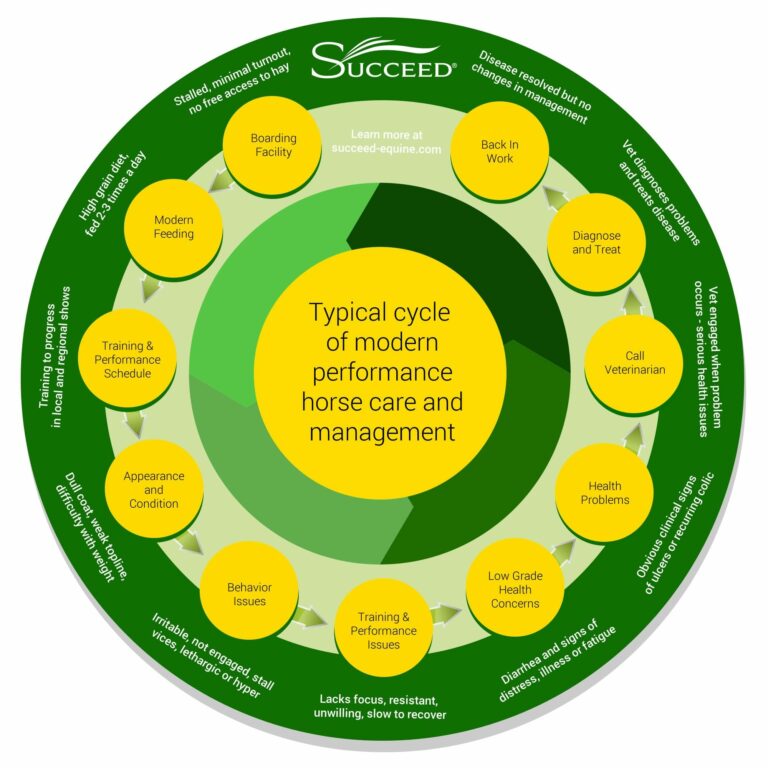
What Can We Do?
We often find ourselves in an unending cycle – problems occur, the vet diagnoses and treats the condition (or only the symptoms), and then it all starts over again.
How can we better manage the horse’s health to address the root causes and avoid these problems in the first place?
We must return to a natural approach to horse care. In an ideal world, we would offer:
- continuous forage,
- unrestricted turnout,
- less grain feed,
- lighter work,
- and more socialization.
Free-access to a variety of rough, fibrous forage is ideal for both nutrition and proper digestive function. The GI tract functions best with constant chewing and a slow and steady intake of grass or hay. Without that, a horse’s health is compromised.
Plenty of room for slow, constant and safe movement while grazing with other horses is necessary for all aspects of wellness. Lack of space to move and escape from other horses contributes to injury risk, social stress and poor GI function. Healthy digestion should prioritize fermenting fiber in the hindgut, not digesting starch and sugar in the foregut.
Finally, in nature horses roam slowly over many miles per day and only use short bursts of speed to escape predators. The added strains of training and exercise, not to mention traveling and competing, challenge normal digestive health.
Competition Training and Care Stress the Horse’s GI Tract
For many reasons, though, competition horses can’t be fully kept within this model. At the least, we need to increase pasture time and the amount of forage in the diet. Other changes can involve reducing stress and the amount of starch and sugar we feed, especially by adding chaff (chopped hay) to grain meals to promote chewing. Also, we can substitute fiber such as (soaked) beet pulp for a portion of the grain.
One method to support digestive health involves providing targeted nutrients that encourage the natural health of the gastrointestinal tract.
Certain nutrients are scientifically shown to enhance the normal structure and function of the digestive tract and allow the horse to mend itself under these conditions. Examples include beta glucan, nucleotides, polar lipids, certain amino acids and yeast.
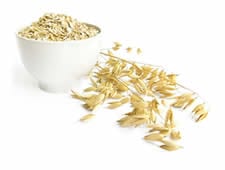
Beta Glucan
Beta glucan is a soluble fiber that is known to be a powerful natural stimulant to the immune system.
Nucleotides
Nucleotides are components of DNA, which are essential for cell reproduction and tissue development.
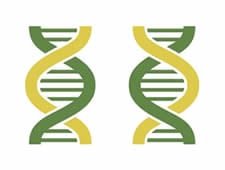
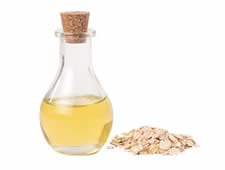
Polar Lipids
Polar lipids are components of oil from certain vegetables which provide a natural protective barrier for tissue, and which have been shown to increase absorption of fat-soluble vitamins (A, K, D and E).
Yeast Products
Some yeast products, especially mannan oligosaccharides (MOS) and yeast beta glucan, are known to bind pathogens, including bacteria and mycotoxins, allowing them to be excreted in the horse’s waste.
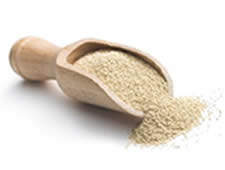
Daily supplementation with products containing these nutrients can help maintain a healthy digestive system, which may reduce the various health and performance issues plaguing our horses.
Your veterinarian should always be active in recommending and managing your horse’s diet regime and when introducing a new supplement program. More and more veterinarians today are introducing wellness programs into their practices, and are open to the value of diet and supplementation as part of the animal’s daily care.
Stop the Cycle to Get Your Horse at its Best
The situation for competition horses and digestive health may seem dire in light of the many challenges. The good news is that modern technology, research and improved understanding continue to further illuminate these issues and improve our ability to respond.
Ongoing research and clinical trials shed light on what is really going on inside our horses, and how that manifests on the outside. Plus the availability of improved diagnostic tools and support products enhance your and your vet’s ability to manage competition horses well.
Horses healthy from the inside out are more willing, trainable partners, able to work to their greatest potential in training and competition.
Horses that are equipped to learn and work comfortably are also less stressed – and therefore more healthy.
Prioritizing digestive health in the competition horse’s feed and management program is an obvious win-win.
References
Dionne, R.M., Vrins, A., Doucet, M.Y., Paré, J. (2003) Gastric ulcers in standardbred racehorses: prevalence, lesion description, and risk factors. J Vet Intern Med.
Julliand, V., De Fombelle, A., Drogoul, C., Jacotot, E. (2001) Feeding and microbial disorders in horses: Part 3—Effects of three hay: grain ratios on microbial profile and activities. Journal of Equine Veterinary Science, 21(11): 543-546.
Luthersson, N., Nielsen, K.H., Harris, P., Parkin, T.D. (2009) Risk factors associated with equine gastric ulceration syndrome (EGUS) in 201 horses in Denmark. Equine Vet J.
McClure, S.R., Carithers, D.S., Gross, S.J., Murray, M.J. (2005) Gastric ulcer development in horses in a simulated show or training environment. J Am Vet Med Assoc.
Milinovich, G.J., Trott, D.J., Burrell, P.C., Van Eps, A.W., Thoefner, M.B., Blackall, L.L., Al Jassim, R.A.M., Morton, J.M., Pollitt, C.C. (2006) Changes in equine hindgut bacterial populations during oligofructose‐induced laminitis. Environmental Microbiology, 8(5): 885-898.
Niedźwiedź, A. Kubiak, K. Nicpoń, J. (2013) Endoscopic findings of the stomach in pleasure horses in Poland. Acta Vet Scand.
Richards, N., Hinch, G.N., Rowe, J.B. (2006) The effect of current grain feeding practices on hindgut starch fermentation and acidosis in the Australian racing Thoroughbred. Australian veterinary journal, 84(11): 402-407.
White, G.l., McClure, S.R., Sifferman, R., Holste, J.E., Fleishman, C., Murray, M.J., Cramer, L.G. (2007) Effects of short-term light to heavy exercise on gastric ulcer development in horses and efficacy of omeprazole paste in preventing gastric ulceration. J Am Vet Med Assoc. 230(11).
Published: September 6, 2017
See what #TeamSUCCEED riders are saying.
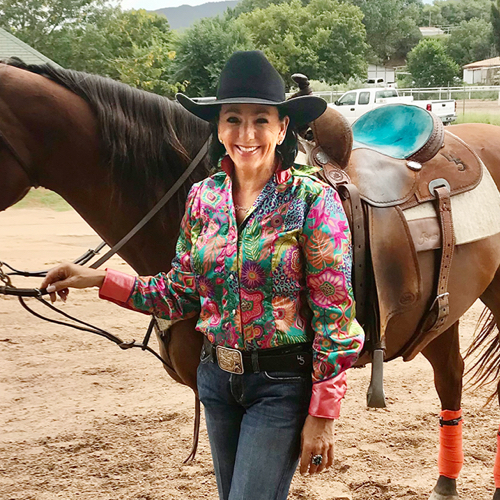
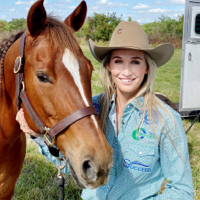
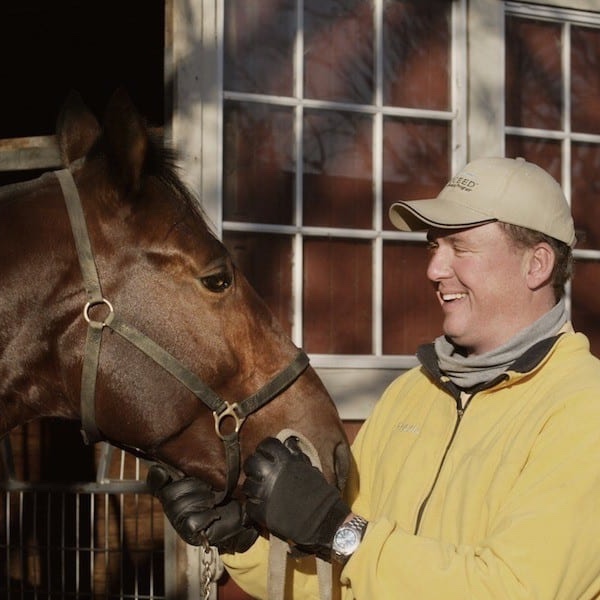



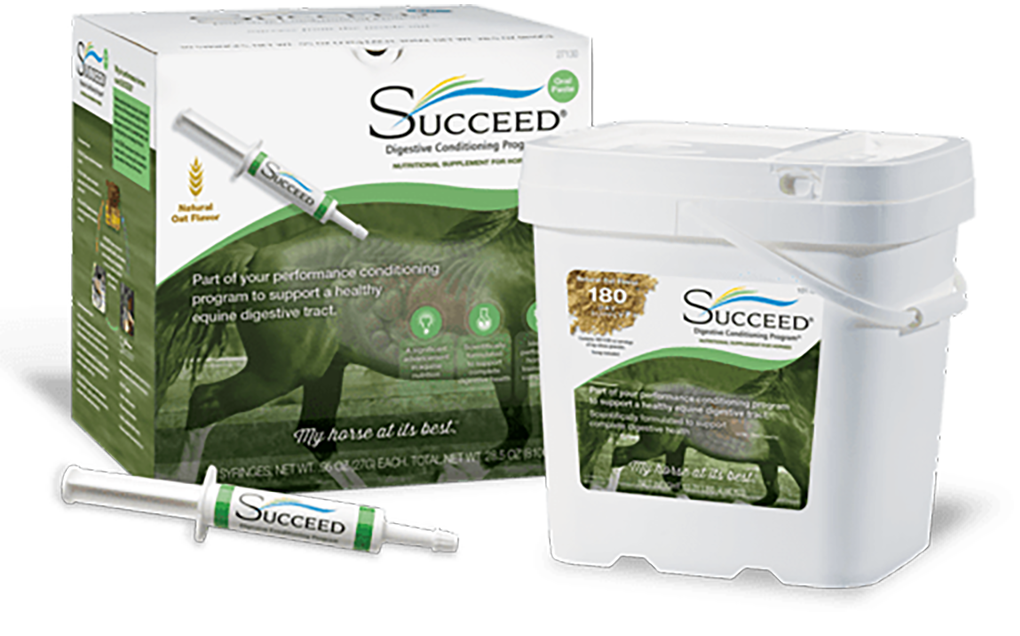
Is SUCCEED right for you?
Find out if your horse’s health and performance could benefit from added digestive support.
